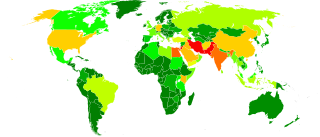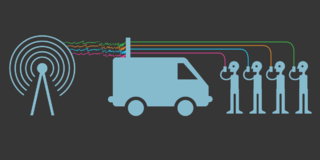Related Research Articles

Surveillance is the monitoring of behavior, many activities, or information for the purpose of information gathering, influencing, managing, or directing. This can include observation from a distance by means of electronic equipment, such as closed-circuit television (CCTV), or interception of electronically transmitted information like Internet traffic. Increasingly, governments may also obtain consumer data through the purchase of online information, effectively expanding surveillance capabilities through commercially available digital records. It can also include simple technical methods, such as human intelligence gathering and postal interception.
Computer and network surveillance is the monitoring of computer activity and data stored locally on a computer or data being transferred over computer networks such as the Internet. This monitoring is often carried out covertly and may be completed by governments, corporations, criminal organizations, or individuals. It may or may not be legal and may or may not require authorization from a court or other independent government agencies. Computer and network surveillance programs are widespread today and almost all Internet traffic can be monitored.
Mass surveillance is the intricate surveillance of an entire or a substantial fraction of a population in order to monitor that group of citizens. The surveillance is often carried out by local and federal governments or governmental organizations, but it may also be carried out by corporations. Depending on each nation's laws and judicial systems, the legality of and the permission required to engage in mass surveillance varies. It is the single most indicative distinguishing trait of totalitarian regimes. It is often distinguished from targeted surveillance.
Harris Corporation was an American technology company, defense contractor, and information technology services provider that produced wireless equipment, tactical radios, electronic systems, night vision equipment and both terrestrial and spaceborne antennas for use in the government, defense, emergency service, and commercial sectors. They specialized in surveillance solutions, microwave weaponry, and electronic warfare. In 2019, it merged with L3 Technologies to form L3Harris Technologies.
An international mobile subscriber identity-catcher, or IMSI-catcher, is a telephone eavesdropping device used for intercepting mobile phone traffic and tracking location data of mobile phone users. Essentially a "fake" mobile tower acting between the target mobile phone and the service provider's real towers, it is considered a man-in-the-middle (MITM) attack. The 3G wireless standard offers some risk mitigation due to mutual authentication required from both the handset and the network. However, sophisticated attacks may be able to downgrade 3G and LTE to non-LTE network services which do not require mutual authentication.
A GPS tracking unit, geotracking unit, satellite tracking unit, or simply tracker is a navigation device normally on a vehicle, asset, person or animal that uses satellite navigation to determine its movement and determine its WGS84 UTM geographic position (geotracking) to determine its location. Satellite tracking devices may send special satellite signals that are processed by a receiver.

Tor is a free overlay network for enabling anonymous communication. Built on free and open-source software and more than seven thousand volunteer-operated relays worldwide, users can have their Internet traffic routed via a random path through the network.
Cellebrite DI Ltd. is a digital intelligence company headquartered in Petah Tikva, Israel, that provides tools for law enforcement agencies as well as enterprise companies and service providers to collect, review, analyze and manage digital data. Their flagship product series is the Cellebrite UFED.

The StingRay is an IMSI-catcher, a cellular phone surveillance device, manufactured by Harris Corporation. Initially developed for the military and intelligence community, the StingRay and similar Harris devices are in widespread use by local and state law enforcement agencies across Canada, the United States, and in the United Kingdom. Stingray has also become a generic name to describe these kinds of devices.
The Geolocation Privacy and Surveillance Act was a bill introduced in the U.S. Congress in 2011 that attempted to limit government surveillance using geolocation information such as signals from GPS systems in mobile devices. The bill was sponsored by Sen. Ron Wyden and Rep. Jason Chaffetz. Since its initial proposal in June 2011, the GPS Act awaits consideration by the Senate Judiciary Committee as well as the House.

Ring LLC is a manufacturer of home security and smart home devices owned by Amazon. It manufactures a titular line of smart doorbells, home security cameras, and alarm systems. It also operates Neighbors, a social network that allows users to discuss local safety and security issues, and share footage captured with Ring products. Via Neighbors, Ring could also provide footage and data to law enforcement agencies to assist in investigations.

The Guardian Project is a global collective of software developers, designers, advocates, activists, and trainers who develop open-source mobile security software and operating system enhancements. They also create customized mobile devices to help individuals communicate more freely and protect themselves from intrusion and monitoring. The effort specifically focuses on users who live or work in high-risk situations and who often face constant surveillance and intrusion attempts into their mobile devices and communication streams.

The practice of mass surveillance in the United States dates back to wartime monitoring and censorship of international communications from, to, or which passed through the United States. After the First and Second World Wars, mass surveillance continued throughout the Cold War period, via programs such as the Black Chamber and Project SHAMROCK. The formation and growth of federal law-enforcement and intelligence agencies such as the FBI, CIA, and NSA institutionalized surveillance used to also silence political dissent, as evidenced by COINTELPRO projects which targeted various organizations and individuals. During the Civil Rights Movement era, many individuals put under surveillance orders were first labelled as integrationists, then deemed subversive, and sometimes suspected to be supportive of the communist model of the United States' rival at the time, the Soviet Union. Other targeted individuals and groups included Native American activists, African American and Chicano liberation movement activists, and anti-war protesters.

In re Application of the United States for Historical Cell Site Data, 724 F.3d 600, was a case in which the United States Court of Appeals for the Fifth Circuit held that the government can access cell site records without a warrant. Specifically, the court held that court orders under the Stored Communications Act compelling cell phone providers to disclose historical cell site information are not per se unconstitutional.

Cellphone surveillance may involve tracking, bugging, monitoring, eavesdropping, and recording conversations and text messages on mobile phones. It also encompasses the monitoring of people's movements, which can be tracked using mobile phone signals when phones are turned on.
Mass surveillance in Australia takes place in several network media, including telephone, internet, and other communications networks, financial systems, vehicle and transit networks, international travel, utilities, and government schemes and services including those asking citizens to report on themselves or other citizens.
ComputerCop is content control software developed by the Bohemia, New York-based company ComputerCop Software. The software offers the ability for users to scan content on a computer for objectionable content, along with a key logging component that allows parents to be notified if certain words are being typed. Upon its original release, the software was endorsed by NYPD detective Bo Dietl, and was originally branded as Bo Dietl's One Tough Computer Cop. It initially only contained scanning software; later versions dropped Dietl's endorsement and branding, but also added a keylogger.
The use of stingrays by United States law enforcement is an investigative technique used by both federal and local law enforcement in the United States to obtain information from cell phones by mimicking a cell phone tower. The devices which accomplish this are generically known as IMSI-catchers, but are commonly called stingrays, a brand sold by the Harris Corporation.
Clearview AI, Inc. is an American facial recognition company, providing software primarily to law enforcement and other government agencies. The company's algorithm matches faces to a database of more than 20 billion images collected from the Internet, including social media applications. Founded by Hoan Ton-That and Richard Schwartz, the company maintained a low profile until late 2019, until its usage by law enforcement was first reported.
Flock Group Inc., doing business as Flock Safety, is an American manufacturer and operator of automated license plate recognition (ALPR), video surveillance, and gunfire locator systems. Founded in 2017, Flock operates such systems under contract with law enforcement agencies, neighborhood associations, and private businesses, and as of 2024, claims to operate in over 5,000 communities across at least 42 U.S. states.
References
- 1 2 3 4 5 6 7 Burke, Garance; Dearen, Jason (September 1, 2022). "Tech tool offers police 'mass surveillance on a budget'". AP News .
- 1 2 Cameron, Dell (September 9, 2022). "What Is 'Fog Reveal,' the Police App Tracking Your Phone?". Gizmodo . Retrieved September 11, 2022.
- ↑ Belanger, Ashley (2022-11-23). "Sneaky ways cops could access data to widely prosecute abortions in the US". Ars Technica . Retrieved 2022-11-24.
- ↑ Mathur, Chandraveer (July 18, 2022). "The US government has been buying vast amounts of phone location data, and that's probably not great". Android Police. Retrieved September 11, 2022.
- ↑ Potts, Caleb (December 11, 2020). "Surveillance companies are using mobile ads to obtain scarily accurate location data". Android Police. Retrieved September 11, 2022.
- ↑ "Big Ass Data Broker Opt-Out List". Google Docs. Retrieved September 11, 2022.
- ↑ Greenberg, Will (August 31, 2022). "Fog Revealed: A Guided Tour of How Cops Can Browse Your Location Data". Electronic Frontier Foundation.
- ↑ "Chino_2019 -20_Attachments". DocumentCloud . Retrieved September 11, 2022.
- ↑ Brodkin, Jon (2024-12-10). "Location data firm helps police find out when suspects visited their doctor". Ars Technica. Retrieved 2024-12-16.
- ↑ Cox ·, Joseph (2024-12-10). "Location Data Firm Offers to Help Cops Track Targets via Doctor Visits". 404 Media. Retrieved 2024-12-16.